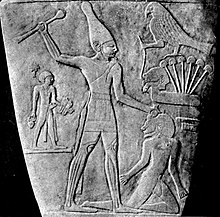Wash (pharaoh)

| ||
| wˁš in hieroglyphs |
|---|
Wash was possibly an ancient Egyptian predynastic ruler. His existence is disputed.
Background[edit]
He is known from the verso of the Narmer Palette found in Hierakonpolis, where he is depicted as a kneeling captive, "un-Egyptian in appearance",[2] about to be smitten by Narmer.[3] The hieroglyphs carved near the captive – a harpoon and a lake – have been considered by scholars to be either a location name for the Harpoon nome (located in the Northwestern Nile Delta next to the Libyan borders) or the personal name of the captive, phonetically read as Washi or Wash.[4][3]
Assuming that Wash was a historical figure, it has been speculated that he may have been the last ruler of a Lower Egyptian dynasty based at Buto, who was ultimately defeated by the Upper Egyptian leader, Narmer. However, it is possible that the Narmer Palette depicts an allegory rather than a historical event, with Wash merely being part of that construct.[5]
Archaeologist Edwin van den Brink argued that Hedju Hor – another predynastic Lower Egyptian ruler – could be identified with Wash, on the basis of the similarities between the former's serekh and the carving above Wash on the Narmer Palette.[6]
References[edit]
- ^ Egypt,” Encyclopædia Britannica (11th ed.), v. 9, 1911, plate II (between pp. 64 and 65),#23.
- ^ O'Connor, David (2011). "The Narmer Palette: A New Interpretation". In Teeter, Emily (ed.). Before the Pyramids: The Origins of Egyptian Civilization. The Oriental Institute of the University of Chicago. ISBN 978-1885923-82-0., p.148
- ^ a b Heagy, Thomas C. (2014). "Who was Menes?". Archeo-Nil. 24: 59–92., p.66
- ^ Helck, Wolfgang (1987). Untersuchungen zur Thinitenzeit. Ägyptologische Abhandlungen 45. Wiesbaden., p.98
- ^ Wilkinson, Toby (1999). Early Dynastic Egypt. Routledge. ISBN 0-203-20421-2., pp.40–41
- ^ van den Brink, Edwin (1996). "The Incised Serekh-signs of Dynasties 0–1, Part I: Complete Vessels". In Spencer, Alan J. (ed.). Aspects of Early Egypt. London: British Museum Press. pp. 140–158. ISBN 0714109991., p.147
| This Ancient Egypt biographical article is a stub. You can help Wikipedia by expanding it. |